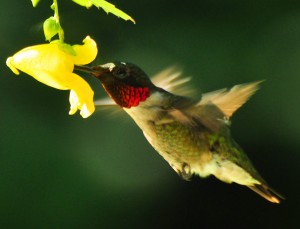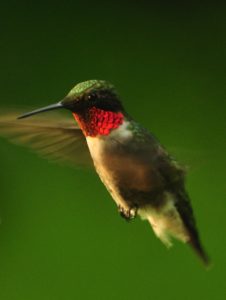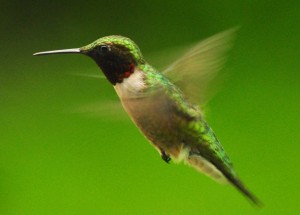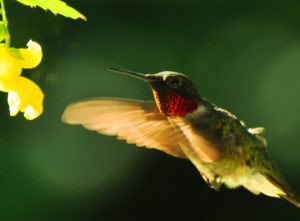Photography courtesy of Lowell Washburn, all rights reserved.
Hummingbirds and Jewelweed
The ruby-throated hummingbird is aptly named. When illuminated by even the slightest hint of sunlight, the male’s ruby red bib sparkles with all the intensity of the finest jewel. The hummingbird’s glossy emerald back is equally iridescent, making the species one of our most attractive backyard birds.
But it is the hummingbird’s unique flight that people find most intriguing. With wings whirring away at an incredible 50 to 200 beats per second, the hummingbird is in a class of it own. Hummingbirds can rocket straight up, fly straight down, or hover in place. They are one of the few birds that can actually fly backwards — for as far as they want.
Although hummingbirds will eagerly guzzle sugar water from hanging plastic feeders; watching them forage among natural stands of wildflowers is a lot more interesting — especially on windy days as plants sway to and fro in the breeze and birds mimic the wildflower’s every move.
It’s late August, and this year’s crop of pale jewelweed is in full bloom. Best known for its orchid-like yellow flowers, the jewelweed is an absolute hummingbird magnet. So much so, that hummingbirds become the jewelweed’s Chief Pollinator.
The association is no coincidence. During late summer, jewelweed becomes the Iowa woodland’s most abundant nectar producing plant; providing hummingbirds with a welcome food source as resident adults, young-of-the-year, and early migrants scour the countryside for nectar. The relationship between hummingbirds and jewelweed is so interlinked, in fact, that most jewelweed patches will not begin flowering until annual hummingbird populations approach their peak.
It’s a time tested, perfect partnership where plant and bird receive equal benefit. As the hovering ruby-throat probes for nectar, the tight fitting, slipper-shaped flower dusts the bird’s forehead with pollen. But although jewelweed nectar is highly nutritious, the yield per flower is small. Consequently, hummingbirds must visit many different flowers to receive a meal. As ruby-throats travel from flower to flower and patch to patch, they unwittingly distribute pollen among many jewelweed plants. It’s a nature tale where everyone becomes a winner.
But the jewelweed story doesn’t necessarily end with hummingbirds. The plant provides human benefits as well. The stem’s clear juice provides a highly effective remedy for a variety of painful maladies including poison ivy and bee stings. The juices also have an anti-inflammatory effect on reactions to stinging nettles; and antifungal chemicals that effectively treat skin disorders. Application is easy; simply break the stem and rub. You won’t believe how fast it works.
Last week, my four-year-old granddaughter came into contact with some stinging nettles while gathering early season walnuts. Fortunately, there were two large patches of jewelweed near the edge of the woods. All it took was the juice from one stem and the burning was completely gone – all in less than one minute.
LW






 Tom Cope
Tom Cope Sue Wilkinson
Sue Wilkinson Susan Judkins Josten
Susan Judkins Josten Rudi Roeslein
Rudi Roeslein Elyssa McFarland
Elyssa McFarland Mark Langgin
Mark Langgin Adam Janke
Adam Janke Joe Henry
Joe Henry Kristin Ashenbrenner
Kristin Ashenbrenner Joe Wilkinson
Joe Wilkinson Dr. Tammy Mildenstein
Dr. Tammy Mildenstein Sean McMahon
Sean McMahon